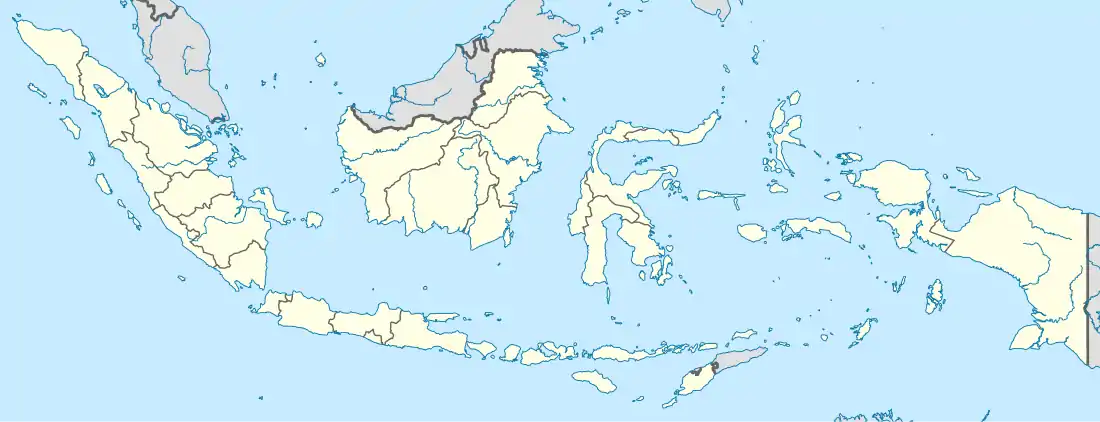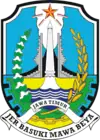Blitar Regency
Blitar Regency is a regency in East Java, Indonesia. It covers an area of 1,558,79 km2 and had a population of 1,116,639 at the 2010 Census;[1] the latest official estimate (for mid 2020) is 1,163,789.[2] Since 2010, its capital has been located in Kanigoro, after sharing the same capital with Blitar city for more than a century.[3]
Blitar Regency | |
|---|---|
 Seal | |
| Motto(s): Hurub Hambangun Praja "The Spirit Build Country" | |
 Location within East Java | |
| Coordinates: 8.13333°S 112.25°E | |
| Country | |
| Province | East Java |
| Capital | Kanigoro |
| Government | |
| • Regent | Rijanto |
| • Vice Regent | Marhaenis Urip Widodo |
| Area | |
| • Total | 1,588.79 km2 (613.44 sq mi) |
| Population (2020) | |
| • Total | 1,163,789 |
| • Density | 730/km2 (1,900/sq mi) |
| Time zone | UTC+7 (IWST) |
| Area code | (+62) 342 |
| Website | blitarkab.go.id |
History
Blitar Regency as an administrative area is believed to be established in 5 August 1324 AD during the reign of King Jayanegara (1309-1328).[4]
Administrative districts
Blitar Regency is divided into 22 districts (kecamatan), tabulated below with their areas and population totals from the 2010 Census[5] and the official estimates for mid 2014.[6] The table also includes the number of administrative villages (rural desa and urban kelurahan) in each district, and its postal codes. The districts are grouped into southern and northern sectors, which have no administrative or legal significance, but are shown to illustrate the much less densely populated southern sector (adjoining the sea) than the northern sector (centred on Blitar city).
| Name | Area in km2 | Population Census 2010[7] | Population Estimate mid 2014[8] | Number of villages | Post codes |
|---|---|---|---|---|---|
| Bakung | 111.24 | 25,011 | 25,463 | 11 | 66163 |
| Wonotirto (a) | 164.54 | 35,253 | 35,552 | 8 | 66173 |
| Panggungrejo (b) | 119.54 | 40,551 | 41,215 | 10 | 66174 |
| Wates (c) | 68.76 | 27,688 | 28,141 | 8 | 66194 |
| Binangun | 76.79 | 42,717 | 42,733 | 12 | 66193 |
| Sutojayan | 44.20 | 46,837 | 47,670 | 11 | 66172 |
| Kademangan | 105.28 | 63,519 | 64,960 | 15 | 66161 |
| Totals - South sector | 689.85 | 281,576 | 285,734 | 75 | |
| Kanigoro | 55.55 | 72,919 | 76,108 | 12 | 66171 |
| Talun | 49.78 | 59,167 | 60,427 | 14 | 66183 |
| Selopuro | 39.29 | 39,319 | 39,759 | 8 | 66184 |
| Kesamben | 56.96 | 48,418 | 48,444 | 10 | 66191 |
| Selorejo | 52.23 | 34,784 | 34,924 | 10 | 66192 |
| Doko | 70.95 | 37,648 | 37,747 | 10 | 66186 |
| Wlingi | 66.36 | 49,902 | 50,168 | 9 | 66185 |
| Gandusari | 88.23 | 66,337 | 66,516 | 14 | 66187 |
| Garum | 65.56 | 62,025 | 64,337 | 9 | 66182 |
| Nglegok | 92.56 | 67,479 | 69,385 | 11 | 66181 |
| Sanankulon | 33.33 | 53,040 | 55,242 | 12 | 66151 |
| Ponggok | 103.83 | 96,783 | 100,303 | 15 | 66153 |
| Srengat | 53.98 | 62,071 | 64,441 | 16 | 66152 |
| Wonodadi | 40.35 | 45,830 | 46,744 | 11 | 66155 |
| Udananu | 40.98 | 39,341 | 40,514 | 12 | 66154 |
| Totals - South sector | 898.94 | 835,063 | 855,059 | 173 | |
| Totals - Regency | 1,588.79 | 1,116,639 | 1,140,793 | 248 |
Notes: (a) including 7 small offshore islands. (b) including 13 small offshore islands. (c) including 8 small offshore islands.
Temples
Because of its strategic location, Blitar has been important for religious activities in the past, especially Hindu. The most famous temple in this area is Candi Penataran located in Penataran village, Nglegok District. According to history, Candi Penataran used to be a temple state or the main temple of the kingdom. Candi Penataran was built when King Kertajaya offered sima to adore sira majesty of Lord Palah in the year 1119 Saka (1197 AD).
Other temples are scattered throughout Blitar, including :
- Candi Bacem
- Candi Gambar Wetan
- Candi Kalicilik
- Candi Kotes
- Candi Sawentar
- Candi Sumbernanas
- Candi Plumbangan
- Candi Simping
- Candi Tepas
- Candi Wringin Branjang
Beaches
- Jolosutro Beach
- Pangi Beach
- Peh Pulo Beach
- Serang Beach
- Tambakrejo Beach
References
- Biro Pusat Statistik, Jakarta, 2011.
- Badan Pusat Statistik, Jakarta, 2020.
- Peraturan Pemerintah Nomor 3 Tahun 2010 tentang Pemindahan ibu kota Kabupaten Blitar dari wilayah Kota Blitar ke wilayah Kecamatan Kanigoro, Kabupaten Blitar, Provinsi Jawa Timur Archived October 1, 2011, at the Wayback Machine
- "Sejarah Kabupaten Blitar". Pemerintah Kabupaten Blitar. 5 June 2012. Retrieved 15 April 2018.
- Biro Pusat Statistik, Jakarta, 2011.
- Badan Pusat Statistik, Jakarta, 2020.
- Biro Pusat Statistik, Jakarta, 2011.
- Badan Pusat Statistik, Jakarta, 2020.


